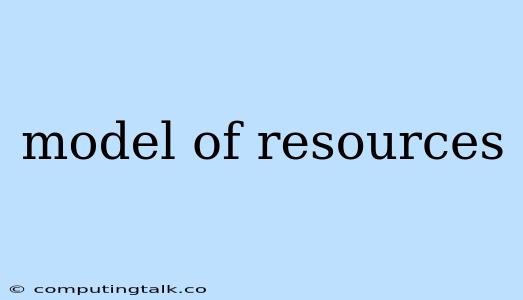The model of resources is a fundamental concept in various fields, from economics to computer science. It's essentially a framework for understanding how resources are allocated, managed, and utilized. Understanding the different models of resources allows us to analyze, optimize, and potentially improve the way we manage and utilize our limited resources.
What are Different Models of Resources?
There are numerous models of resources, each with its own strengths and weaknesses. Here are some of the most common ones:
-
The Scarcity Model: This model emphasizes the limited nature of resources. It posits that human needs and wants are unlimited, while resources are scarce. This fundamental principle drives economic decision-making, leading to competition for resources and the need for allocation mechanisms.
-
The Renewable Resources Model: This model focuses on resources that can be replenished over time, such as solar energy, wind power, and forests. It highlights the importance of sustainable practices and conservation efforts to ensure the continuous availability of these resources.
-
The Non-Renewable Resources Model: This model deals with resources that cannot be replenished at a rate comparable to their consumption, such as fossil fuels and minerals. It emphasizes the need for careful management and exploration of alternative resources to prevent depletion and ensure long-term availability.
-
The Human Capital Model: This model focuses on human resources, recognizing that individuals are the most valuable asset in any economy. It emphasizes the importance of education, training, and healthcare in developing and enhancing human capabilities.
-
The Knowledge Model: This model highlights the role of knowledge as a critical resource. It emphasizes the importance of sharing, creating, and disseminating knowledge to drive innovation and economic growth.
How are Models of Resources Used?
Understanding these models allows us to:
-
Allocate resources efficiently: By analyzing the availability and demand for resources, we can allocate them effectively to meet critical needs and achieve desired outcomes.
-
Manage resource depletion: By recognizing the finite nature of certain resources, we can implement strategies to minimize their depletion and find alternative solutions.
-
Promote sustainable practices: The model of resources helps us understand the importance of sustainable practices, such as recycling, renewable energy, and conservation, to preserve resources for future generations.
-
Develop economic policies: By understanding the different models of resources, policymakers can design policies that encourage resource conservation, promote innovation, and enhance overall economic efficiency.
What are Some Examples of the Model of Resources in Action?
Here are some examples of how models of resources are applied in real-world situations:
-
Water management: By understanding the scarcity of water in certain regions, governments and organizations implement water conservation strategies, develop desalination plants, and promote efficient irrigation methods.
-
Energy production: The model of resources informs the development of renewable energy sources, such as solar and wind power, to reduce dependence on fossil fuels and mitigate climate change.
-
Human resource development: By recognizing the value of human capital, companies invest in employee training and education to enhance productivity and foster innovation.
-
Information technology: The model of resources highlights the importance of data and knowledge as resources, leading to investments in data analytics, artificial intelligence, and information management systems.
How can I Use Models of Resources in My Work?
Here are some practical tips:
-
Identify and prioritize resources: Understand the different types of resources available to you and prioritize those that are most critical to your success.
-
Analyze resource constraints: Assess any limitations or constraints related to your resources and identify potential solutions.
-
Develop resource allocation plans: Create clear plans for allocating your resources effectively to achieve your goals.
-
Monitor and evaluate resource utilization: Regularly track how you are using your resources and make adjustments as needed.
-
Foster resource sustainability: Implement practices that minimize waste, conserve resources, and ensure their long-term availability.
Conclusion
The model of resources provides a valuable framework for understanding how to manage and utilize our limited resources effectively. By applying these models, we can make more informed decisions, promote sustainable practices, and ensure the long-term availability of essential resources. By recognizing the value of various resources, from natural resources to human capital and knowledge, we can work towards a more sustainable and equitable future.
